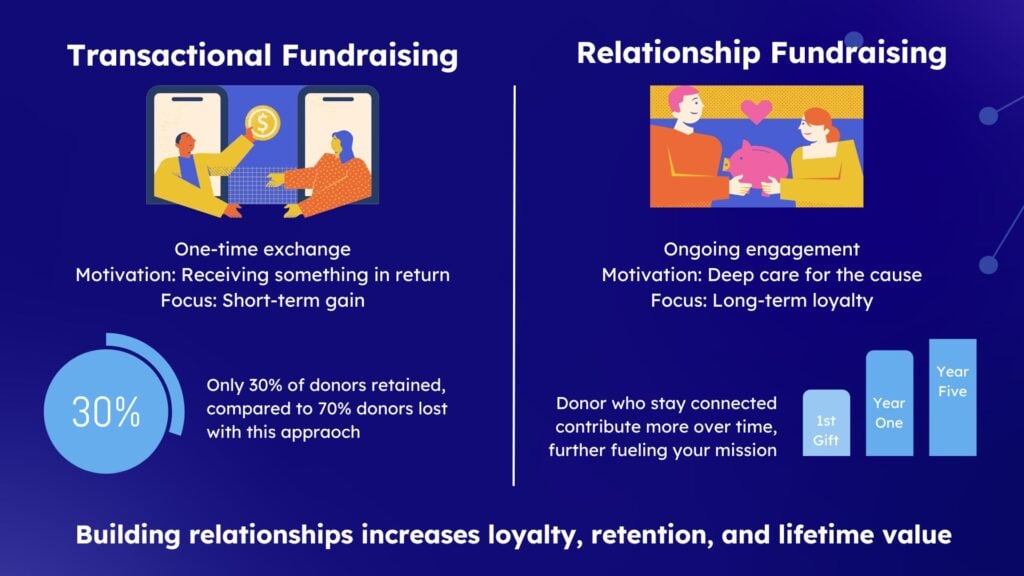Transcending the Transaction: Relationship Fundraising

There’s one simple truth in fundraising: people will support the things they care most about. However, a single gift doesn’t necessarily imply a deep-seated concern for the issues you aim to solve.
Say you run an animal shelter and offer address labels as an incentive for someone to make a first gift. In response, a donor writes you a $20 check. Do they really care about animal welfare, or do they just want address labels with your logo?
At a deeper level, fundraising is transactional: I give you something, and you give me something in return for my charity. The benefits vary — a discount to your local art museum, a branded T-shirt, a gift card. But once the benefit is exchanged or used, what’s left to keep a one-time donor coming back?
With both donor acquisition and retention becoming more challenging, your organization must aspire to forge relationships with donors that go beyond a single transaction in order to deepen your donors’ affinity for your cause.
Transactional Fundraising vs. Relationship Fundraising
In transactional fundraising, someone donates to you in exchange for something else. Think cookies at a bake sale, early access to priority seating, or even a nice blanket. They don’t necessarily care about what their money supports — they simply want the benefit.
By contrast, relationship fundraising is a deeper, more personal connection. The donor has deep-rooted care and concern for your cause and wants to stay engaged with your work.

Let’s be clear: transactional fundraising isn’t a bad thing. In fact, many donors come to your organization through an initial transaction. The key is to turn that transactional acquisition into a relationship through meaningful outreach and stewardship.
Say you rely on 1,000 donors to give you $10 each. If the relationship with you is based on a single, shallow transaction, you would be lucky to keep 30% of those donors for a second gift, meaning you’ll need to replace 70% of them. But if you can build relationships with just half of those donors so that they make additional gifts or become sustaining givers, you can raise more dollars with fewer people.
Turning a transaction into a relationship brings three essential benefits:
- Boost donor loyalty, longevity, and lifetime value: The average monthly gift is $24 (or $288 yearly), while the average one-time gift is $115. And while revenue from one-time online gifts fell 5% in 2023, revenue from monthly gifts rose 6%.
- Increase retention rates: In general, less than half of all donors will give the following year. Retention rates for new donors typically hover around 20%, but rates for monthly donors top 80% after the first year and 95% after the fifth year. Moreover, just a 10% improvement in donor retention rates can increase a donor’s lifetime value by 200%.
- Attract younger donors: Younger generations tend to be put off by overt donation requests. Instead, they want a sense of connection and belonging to a nonprofit. Focusing less on the transaction and more on the relationship lets you show precisely how much the donor and their gift matter.
Download a free copy of “How Relationship Fundraising Works,” an eBook that unlocks the potential of donor-centric fundraising.
How to Turn a Transaction into a Relationship
Building relationships with donors isn’t easy, especially if your organization has relied on a transaction-based model. The following strategies can help you transcend the transaction and turn a single gift into long-standing support.
Make the Transaction Easy
Any initial transaction with your organization should be simple. Don’t make people create a website account, and don’t bombard them with additional asks. This should be a quick and pleasant experience that lets them accomplish what they want to achieve and nothing more.
Then, try to get a second gift as quickly as possible by creating a case for why their donation is essential to your work. For instance, you might follow their transaction with a thank-you email that outlines the difference their initial gift made and explains why they should continue their support.
Say you operate a local food bank, and a tornado strikes your town. Donations will likely surge in the moment but wane over time. After the initial rush, thank donors for their gifts, then share examples or testimonials of the work you do in the community every day. Explain how the donor’s continued support helps their neighbors in need year-round.
Adopt a Subscription Model
Modern commerce has conditioned people to pay monthly for everything from streaming services to meal prep kits. To take advantage of this, add a monthly membership or giving program to your fundraising model.
Consider the initial transaction as a conversation starter. Ask the donor to opt in to receive communications and invite them to follow you on social media. Then, share your work’s impact through compelling storytelling, imagery, and videos to demonstrate your ongoing need.
If the donor reacts positively to your outreach (i.e., they interact with your social posts and don’t unsubscribe from emails), present your monthly giving or membership program as a convenient way they can continue their support.
Once they sign up, keep the engagement coming. A 2018 survey found that 91% of organizations stopped acknowledging a recurring gift after the third month. Yikes! Monthly donors are often willing to support additional one-off campaigns, so stay on their radar.
Follow the For-Profits
For-profits are conditioning consumers beyond just subscription models, and nonprofits should follow their lead. Consider how detailed shipping information has become. You can now track a package from the warehouse straight to your front door.
This level of communication builds trust through transparency. Yet too many nonprofits accept a donation, give a cursory thank-you, and never follow up with the impact, leaving donors to feel like their gift disappeared into a black hole.
Inexpensive stewardship tools like social media and text messages help you keep donors informed with regular updates on your work. Even if photos and videos from the field aren’t professionally produced, they can be incredibly moving. For instance, if you’re on the ground feeding those affected by a hurricane, snap a few pictures of your setup and send them along with a thank-you message to your donors.
Seeing their donation at work will reinforce their positive feelings of doing something good for others. This endears supporters to your organization and inspires additional gifts.
ID the Right People for Long-Term Giving
Unfortunately, not every transaction will lead to a relationship. A vacationing family who signs up for your museum membership likely only wants the discount. If they don’t visit your city regularly, they won’t be interested in a relationship with your organization.
There are a few ways to identify one-time donors who may be good candidates for long-term giving. One is to look at the value of their cumulative giving over time. Someone who regularly gives to your disaster relief efforts is more likely to enroll in recurring giving. Be sure to track those who return to you with support so you can thank them appropriately and start building a relationship.
You can also use data to uncover donors with long-term potential. Tools like GivingDNA can create lookalike cohorts based on your existing loyal donors so you can target these groups for stewardship. You can also see people who donate to causes like yours.
Relationships Start with the End in Mind
As you shift toward relationship fundraising, it’s important to be intentional. Let data drive your strategies to ensure you target the right donors for long-term engagement. Connect with next-generation donors to diversify your donor file. Utilize an omni-channel approach to meet donors where they are — social media, text, and email.
An acquisition strategy is critical to learning how to acquire loyal donors for your organization. You’ll work smarter, pulling from a smaller pool of donors who are more likely to care about your cause and want to offer lasting support.
Finally, develop a communication strategy to cultivate first-time donors. The welcome and thank-you messages you send after the first gift set the stage for further outreach. Consider the next desired action you want that donor to take and map out your messaging accordingly.
Our Allegiance Group + Pursuant team is eager to help you transcend transactional fundraising. We also invite you to download a free copy of “How Relationship Fundraising Works,” an eBook that unlocks the potential of donor-centric fundraising. We recently updated this comprehensive guide so you can build more meaningful relationships with today’s donors.
This blog post is based on a recent episode of the Go Beyond Fundraising podcast. Listen to the complete episode now: Beyond Transactions: How Relationship Fundraising Builds Donor Loyalty and Lifetime Value